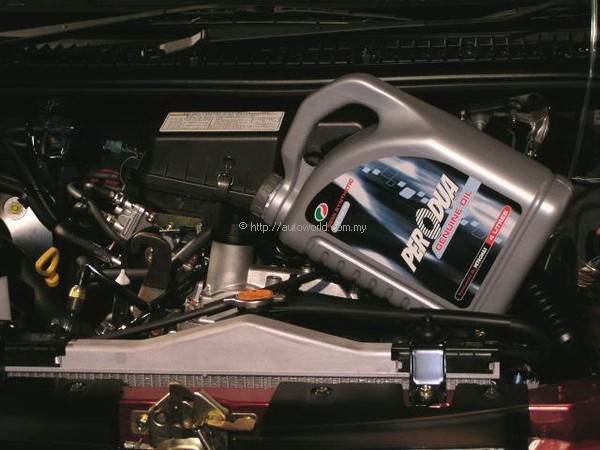The Case for Genuine Oils
There are engine oils and there are Genuine Oils and to the average motorist, it is hard to understand what can be so special about Genuine Oils sold by some car companies (eg Toyota, Honda and Perodua). It may seem like such products are created just to give the car company an extra source of revenue and depending on the company, the recommendation to use their oil can be subtle or forceful.
Generally, you can use any engine oil which meets the specifications stated in the Owner’s Manual. Typically, these would be the API (American Petroleum Institute) service standard which has been around for over half a century and is the most recognized standard by consumers. The latest one is the ‘SL‘ standard for oils used in petrol engines. There are other standards such as the European ACEA and the Japanese JASO also listed to cater for customers in different regions of the world.
The second important thing in choosing the oil is the viscosity – its thickness at different operating temperatures – and this requirement varies according to the climatic conditions where the vehicle operates as well as the engine design. The viscosity is identified by grades such as SAE5W/30 or SAE 20W/50.
For example, in temperate countries, thinner oils are usually recommended because the oil should not be too thick when cold otherwise it won’t circulate quickly when starting the engine. If the oil is slow to circulate, extra wear will occur. In hot climates such as Malaysia’s, thin oils are not so suitable as the higher temperatures can cause the oil to burn off a bit and require frequent topping up. So a thicker viscosity is better but it must not be too thick either otherwise there will be too much resistance and performance will be affected.
The viscosity also influences engine performance and a thinner oil means lower friction and this can improve output. So there needs to be a balance in this aspect and furthermore, with older engines that have greater tolerances between parts, an oil that is too thin may not be so suitable.
You won’t go wrong picking an oil produced by any of the reputable oil companies but you may not get 100% lubricating performance with the engine in your vehicle. This is because each engine has its own characteristics and design features; some may have unique combustion chamber designs, more complex valvetrains or special oil passages. These are known to the engineers who design the engines but may not be understood by those in the oil companies who try to come up with an oil which ‘suits all engines’.
This is where the specifications for a Genuine Oil come in and they may have specific requirements to ensure proper lubrication in certain areas or as in the case of Perodua Genuine Oil, omit magnesium so as to cut down deposit formation as much as possible. In the API standard, there may be a certain deposit level specified and it could be low but the engine manufacturer’s standard could be more demanding that even that low level. In other words, the Genuine Oil will have a unique formulation which will work best with the engine for which it is recommended, and it will perform better than other oils.
The best analogy to this issue would be to think of clothes. You can go to a department store and buy a shirt with a famous brand name. You may get a choice of S/M/L/XL and one of the sizes will fit your body. Maybe you will be lucky and the sleeves will also be just the right length and the collar is not too tight. However, it is also possible that your arms may be just a wee bit longer and the sleeve length for size ‘M’ is not exactly matching for you.
Now you could also go to a tailor and make a shirt with a similar design but you would be able to have the sleeves just the right length to suit your arm and the collar will be comfortable instead of choke you each time you have to wear a tie. You feel comfortable wearing the shirt and its ‘specifications’ are exclusive to you.
That is basically the difference between a Genuine Oil and other oils: customization. While it may be that 99% of engine designs are similar, there may still be that 1% which is unique to each engine and only a Genuine Oil would be able to cover the lubrication needs of that 1% so you get optimum performance.
The same thing about unique specifications can be said about Genuine Parts although in this case, the automakers usually have higher demands in terms of performance and service life. For example, the manufacturer of a windscreen wiper blade may have an in-house standard of 12 months life but when an automaker takes the same design and wants to sell it as a Genuine Part, the requirement may be that the blade must last 18 months at least. This may require a different type of rubber or processing method to achieve that extra life.
Genuine Parts could cost more or less, depending on the marketing strategy of the company. In the case of Perodua Genuine Oil, the omission of magnesium and the use of a calcium-based alternative is an extra cost because magnesium additives are more commonly used and therefore cheaper. However, Perodua can’t charge customers much more for its new oil because of competitive reasons so together with Petronas, a reasonable price has to be arrived at.
This is not to say you must use only Genuine Oil for your vehicle and that other oils are not good enough. As a consumer, you should always have choices and it is up to you which one you want to have in the engine. The only things to note are that you buy a reputable brand and avoid using after-market additives which may spoil the ideal recipe which the oil company has spent huge sums of money to formulate.
It might also be useful to know that while the API standard is widely recognized and referred to, it may not necessarily be the ideal standard for all motorists. This is because the API standard is largely influenced by the US industry and regulations, particularly fuel economy issues. Therefore, in formulating the API standards, more attention is often given to getting oils to help achieve better fuel economy. Of course, other aspects also get upgraded with each new standard introduced to produce better oils. Furthermore, API standards would also, understandably, have larger engines common to the US market as reference units.
The European ACEA standard is less well known to Malaysians and this standard is known to focus on engine wear. Sure, there are also requirements for certain friction levels to get better fuel economy but the European manufacturers are aiming for longer engine life and oil change intervals, so they want wear to be cut down as much as possible and ACEA tailors its standards in this direction.
As for the Japanese, there is the JASO standard which is even less well known in the global context and JASO standards often emphasize low ash and deposit. The Japanese automakers, which make mostly small engines (under 2 litres), want to get the most out of the small displacements so minimizing deposits and friction are vital. Perhaps wear is of a different priority in their standards since their model cycle changes are faster so they may not feel the need to focus on extra-long engine life.
So the next time you buy oil, be sure to read the label and check out the standards!























